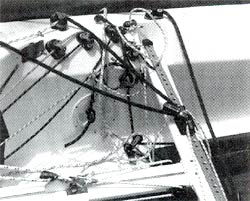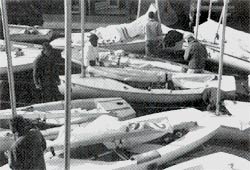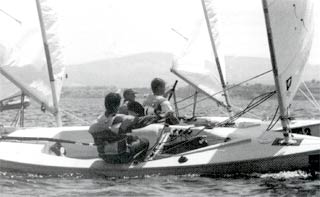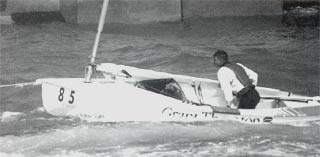 |
| 7. Finn Fundamentals |
by Robert Deaves |
|
Although at first sight the Finn rig may seem to be a relatively simple piece of gear compared with other boats of a similar size, almost as many problems can be encountered in tuning it as in two-sailed boats. The first difference that a novice Finn sailor will notice is that the boom is sheeted at an angle to the centreline and never on the centreline. Because the Finn does not have a foresail, airflow is not directed onto the back of the mainsail. The airflow therefore breaks away from the lee side of the sail earlier than it would if a foresail were present.
To move this break point further aft the maximum draft is cut into a Finn sail at about half the chord length back from the mast.
|
 |
|
This produces a resultant forward-force which is angled further aft than it really should be. To overcome this, the traveller is positioned nearer to the gunwale to increase the angle of the boom to the centreline and hence shift this resultant force-angle to point further forwards so that the driving force is moving the boat forwards rather than sideways. (The further the boom is let out the further forward this force-angle points.)
As the wind increases the draft is pushed aft in the sail, so the boom should be let out more to compensate. The windier the conditions are, the further the boom is let out. It should never really be sheeted further in than the inner sidedeck and the end can sometimes be a matter of several feet away from the gunwale in a strong breeze. |
 |
Mainsheet
Often overlooked in the finer points of sail control, the mainsheet has more effect on sail shape than all the other controls put together. Before you are fully powered up, (and the boom is on the deck anyway), mainsheettension is critical both to pointing ability and to power. When the mainsheet is pulled in, the sail is progressively flattened and the leach tensioned. This action causes the leech to hook, so some inhaul/outhaul tension may be needed to open it up again. Flattening the sail will help you to point higher although some power will be lost. Easing the sheet will have the reverse effect in that you will gain power but lose some of your pointing ability because of the lack of tension in the leach.
|
|
In all instances a compromise is necessary when deciding whether to go for power or pointing - you cannot always have both. Care should be taken when setting the sheet so that it is not under-sheeted (giving you lots of power but no pointing) or that it is over-sheeted (making you point very high but travelling very slowly) and it should be appreciated that the mainsheet should always be used in conjunction with the other sail controls to obtain the best shape for the conditions of the day.
When you are fully powered up and hiked out, the end of the boom will be strapped down onto the aft deck. The only thing that then controls the leach tension is the mast rake. If you move the mast forward, which decreases mast rake, you increase leach tension; move the mast aft, which increases mast rake, and you decrease leach tension. This is why mast rake is so important on the Finn, because with the boom end on the deck in most wind strengths, it is the only thing that controls leach tension - the vital element in fast Finn sailing. |
 |
Mast Rake
Mast rake is measured by hauling up a tape measure on the halyard and measuring the distance to the centre of the transom. On the older boats this was easily done as the mast gate was fixed in the deck, so the measurement for one type of boat would generally be transferable.
Since the advent of the adjustable mast gate, sailors can now adjust both step and gate, allowing a wider range of measurements to be used (and a wider range of helm weights to sail the boat). On the old boats, a figure of 6800 mm mast rake would get you in the right vicinity, however the difference between fast and average speed can be as little as 10 mm difference in mast rake, so it needs to be fine tuned depending on your mast and sail.
|
|
Hulls
Perhaps one of the most important things to consider if you are buying a secondhand Finn is the centre of gravity numbers. In 1974 a test was introduced to the Finn class by Gilbert Lamboley that allowed the distribution of weight in the hull to be accurately determined and controlled. Early on in the Finn history it was found that boats with light ends were faster than those with heavy ends and before the introduction of the Lamboley test this fact could be exploited by centralising weight in the boat. Fast Finns will have the centre of gravity as far aft and as low as possible and will have a minimum radius of gyration (how light the ends are). |
 |
Rig Critique
Finding the correct mast/sail combination for you is arguably the most crucial consideration when preparing a Finn for racing. Without a matched rig you will never get the best out of your Finn. As a general rule the heavier you are the stiffer the mast that you can have, but you need a sail that matches that mast in order to reap the benefits of having the perfect mast. Having found what is a good mast for you, a sail must be found that has a luff curve that matches the bend characteristics of your mast. You can find out what these are by supporting the mast between the heel and the mast ring, bending it under a known load (say 20 kg) suspended from the mast head and measuring the deflection of the mast from the straight line between the upper and lower measurement bands. This needs to be done for fore-and-aft bend and for sideways bend. The figures that you arrive at will help the sailmaker build a sail to suit that mast.
|
|
These figures do not give some ultimate reading, they only give static deflection characteristics which are only useful for comparing different masts. The luff of your sail can also be recut to suit the bend characteristics of your mast by making adjustments in the luff tape along its length. These alterations may be between 3-10 mm, which may seem small but this can make a large difference to boat speed and control of the sail.
Steering
After the mainsheet, the rudder is arguably the most effective control on the Finn, and incorrect use of it is probably a major reason for lack of boat speed. Upwind in a breeze, it needs to be used constantly and sometime aggressively to get the most out of the boat, steering hard through the gusts and around each wave. Offwind it needs to be used discriminately - too little and you miss waves and get nowhere, too much and it acts like a very large brake.
Watch what the top sailors do as they disappear off the start line and learn from them. When you learn that, watch how they steer offwind. It will probably appear that they are going significantly faster than you without much effort, but this is because they have perfected the technique and are at one with the boat and the waves. This can only come about after much practice and a lot of time in the boat.
|
 |
|
Sail Control
The majority of sail setting sense will come from sailing the boat, getting experience and speaking to the experts. Perhaps the most important thing though is balance. With experience you will be able to judge what is the best balance. Is the mainsheet too tight or too loose? Is the sail too far out or too far in? After a while it should become apparent what is fast and what is slow. You will develop a oneness with the boat and the rig. You will be able to squeeze that last bit of speed out of it just by feeling your way with the mainsheet, the tiller and use of your bodyweight. This won't be automatic or quick, it will only come about after you have spent a lot of time practising, practising, practising... This is often what separates the front from the middle of the fleet - just that little bit extra to pull out a lead and not get swallowed up in the pack. |
Buying Secondhand
If you buy secondhand it is crucial to check certain areas to make sure you are buying a boat worth having. Check the mast step for wear into the hog and for lateral security to see whether it is likely to break. This is an area of very high stress. Also check that the mast gate is secure and tight fitting. Look also for damage to the deck around the gate. On GRP boats check the seal between the hull and the deck for signs of leakage. Check the toestraps and the fittings to see if these are secure, firmly bolted down and have not distorted the hull.
The hull needs to be fair and not damaged -especially along keel band area and transom. A badly scratched hull may indicate that the boat has not been too well looked after and may develop other faults later on. Likewise the double-bottom (if it has one) should be checked for cracks and leakages.
|
 |
|
Lastly, if possible, weigh the hull (even get it swung for the Lamboley test). Figures which are way off could indicate a slow boat that might best be avoided.
Fitting Out
If you buy a new Finn, it will come fully fitted out and there is little need to make adjustments of any sort. If you are buying an older Finn that needs a refit then there are several things to consider that are quite important.
Many older boats had dual compasses, one on either sidedeck just forward of the hiking position. These were frequently damaged due to their vulnerable position. Modern boats normally have just one central fitted compass, just forward of the centreboard case and this is perfectly adequate providing it is big enough to read as you are crashing through waves covered in spray. Also make sure that the centreboard does not travel too far forward and smash it.
Rudder security is a must. If your rudder becomes detached from the boat, it can be a disaster. Make sure that it is securely tied on or use a strong rudder clip that will not fail -even if the boat is bouncing around in waves upside down! Similarly, the mast must be secure in the boat. Some older metal masts had pegs at their base that slotted into a groove under the mast step. With modern shoe type mast steps this is not possible, so a piece of cord tied from the mast gate round the gooseneck is adequate - as long as it is tight enough. |
 |
Because the centreboard is heavy, a capsize will invariably result in the board disappearing up the case. Therefore an elastic shockcord arrangement is mounted from the centreboard and around the centreboard case so that the board is forever forced down. Thus when the boat is inverted, the board remains extended by the pull of the shockcord.
Get Well Padded
In the early days of Finn sailing, pain was a fact of life. These days you can have padding on your toestraps, padding on your sidedecks and even padded-battens on your legs. Removal of pain can generate the biggest increase in boat speed of them all. At the end of a long hard race, he who can hike hardest will inevitably win the battle. The more comfortable you are the better you will be able to concentrate on tactics, strategy and boat speed. |
|
Fit for the Job
A control line system and any fitting is only good enough if you are happy using it and can get along with it. If you can't, then something has to be done to remedy the matter. Make sure that all lines can be reached with ease from wherever you might be sitting. Ensure that fittings are not going to be in the way of ropes or any part of you. Plan ahead in any fitting out process so that everything is logical and will function accordingly. Most of all use gear that you can trust not to fail when you need it most. To get the most out of them, Finns need to be pushed hard and gear failure should never be an excuse for not finishing a race. Make sure that whatever fittings and rope you finally decide on, they will not break in a windy race or fail to work effectively when used to the limit. If you are confident that the boat will stand up to the extremes of the weather, then in anything less than the extremes, you can push the boat as hard as you like without worrying about gear failure and damage. |
 |
Fitness
Being fit is as much a part of being a competitive Finn sailor as getting the right gear, and conversely having the best gear in the world is not going to do you any good if halfway up the first beat you're already dead-beat with exhaustion. The best training for Finn sailing itself is really Finn sailing but other training can help supplement water based activities. You need to consider various aspects of getting fit, not just physically, but also mentally.Physically you need stamina (aerobic fitness - running, cycling swimming etc); you need strength (circuits or weight training); you need speed (anaerobic fitness - interval training);
|
|
you need suppleness (flexibility and stretching) and you need skill (go sailing and train intensively). Mentally, use the techniques available, read the recommended books and do everything you can, so when it comes to the crunch you're not let down by your mind.
Commitment
Finn sailing offers some of the most rewarding sailing around. Those who sail the boat competitively and successfully know that in order to succeed they need to apply mind and body to all aspects of racing, tuning and fitness. To make it to the top in Finn sailing requires a dedication to your purpose and a single minded ambition to be the best. Nothing less will do. Train hard, work hard and give it your best, but remember to have fun along the way. |
|